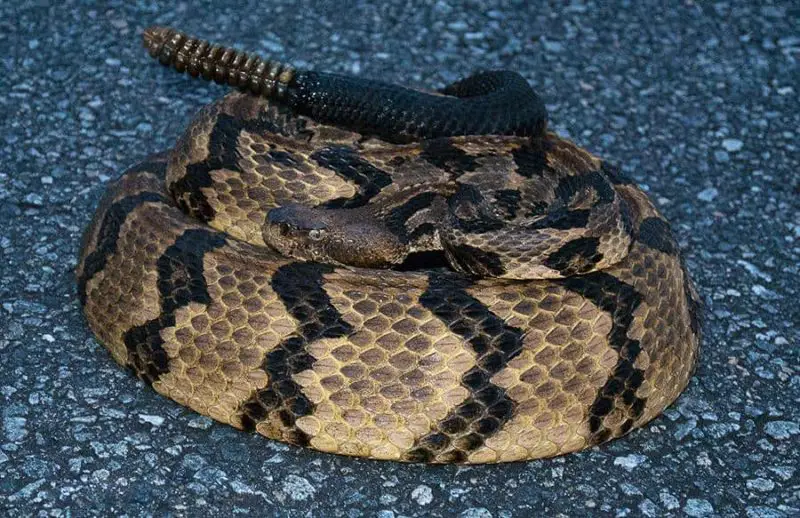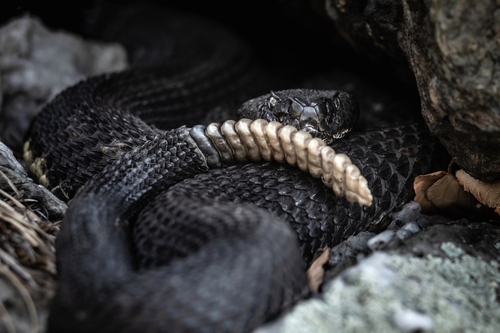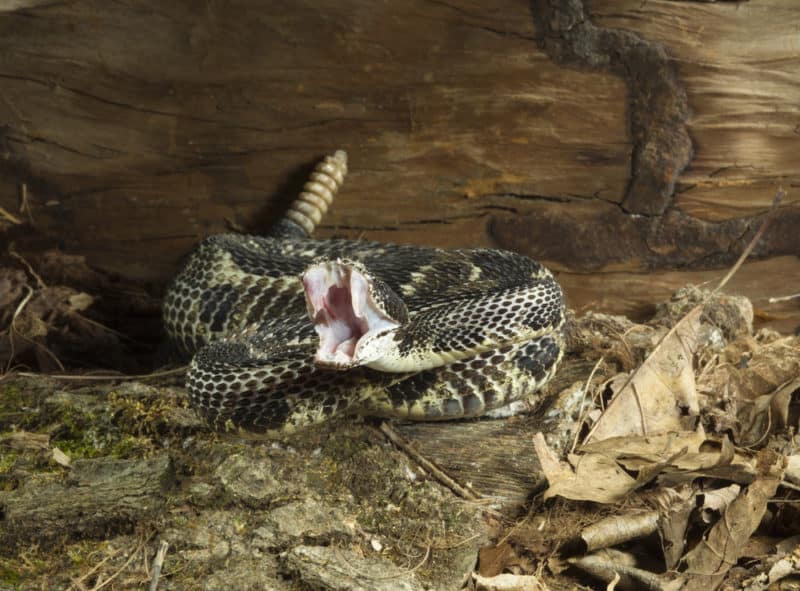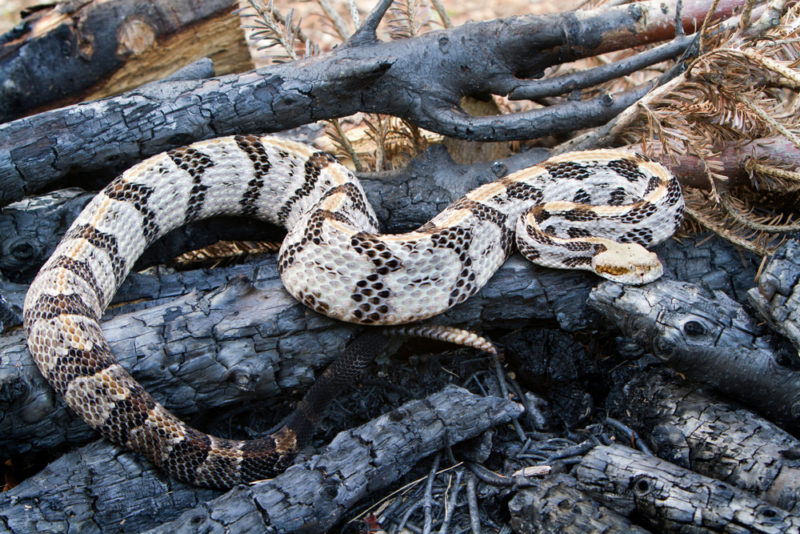The Timber Rattlesnake is the only species of venomous snakes in New Hampshire. Timber rattlers once played a vital role in the ecosystem of New Hampshire. They are on the brink of extirpation today in the Granite state.
Extensive human development and disease are a couple of the factors that make the existence of Timber Rattlesnakes in New Hampshire a tenuous proposition.
In this reference, we’ll talk about these venomous snakes and some of the factors affecting them in New Hampshire. We’ll also tell you what you can do to stay as safe as possible in New Hampshire’s Timber Rattlesnake habitat.
Pit Vipers: The Venomous Masters of Infrared Detection
Rattlesnakes, Copperheads, and Cottonmouths are North American members of the Crotalinae subfamily of the Viperidae family of venomous snakes. They are also referred to as pit vipers.
Since the Timber Rattlesnakes in New Hampshire are pit vipers, let’s look at some pit viper characteristics.
What Makes Pit Vipers Unique?
- Infrared-Sensing Pits:
A defining feature of pit vipers is the deep facial pit between their nostril and the eye on each side of their head. These specialized infrared-detecting organs allow pit vipers to sense heat emitted by prey. This adaptation enables them to:- Detect body heat from up to 1 meter away.
- Strike prey with pinpoint accuracy, even in complete darkness.
- Triangular Heads and Vertical Pupils:
- Head Shape: Pit vipers are recognized by their distinct triangular-shaped heads, which house their venom glands.
- Eyes: They have vertical elliptical-shaped pupils.
- Venomous Fangs:
Pit vipers have hollow fangs connected to venom glands. These fangs fold back against the roof of their mouth when not in use.
Ecological Importance
Pit vipers serve as a check to rodent populations. Despite their fearsome reputation, these snakes are vital to the health of many habitats.

Timber Rattlesnakes in New Hampshire (Crotalus horridus)
Timber Rattler and Canebrake Rattlesnake are both common names for the Timber Rattlesnake. Generally, in higher-elevation habitats, they are called Timber Rattlesnakes. On the coastal plain, though, they’re called Canebrake Rattlesnakes.
What Do Timber Rattlesnakes Look Like?
| Size | *Average length: 36 to 60 inches (0.91 to 1.52 m). *Rare cases reported: Up to 7 feet (2.13 m). |
| Coloration | *General base color: Yellowish-brown to grey-brown. *Chevron pattern: Dark brown to black chevrons on their back and sides against a lighter base color. *Back stripe: Rusty to reddish stripe running down their back. *Tail color: Dark brown or black. |
| Melanistic Variation | *Some timber rattlesnakes exhibit a dark, melanistic color morph. *These snakes can appear almost entirely black. *The tail is darker than the rest of the body in this morph. *All of the Timber rattlesnakes known to live in New Hampshire are black. |
| Behaviors | *These snakes are excellent climbers. In fact, timber rattlers have been found in trees at heights of more than 80 feet. *The experts have proven that timber rattlesnakes help control Lyme disease. This is because as they consume rodents, they’re also consuming ticks. A timber rattler will consume 2,500 to 4,500 ticks per year, depending on the location. |
| Conservation status | They are endangered in New Hampshire. Only one known population exists in the state. |
Snakes That Look Like Timber Rattlesnakes
The northern water snake and the eastern hognose snake are sometimes mistaken for Timber Rattlesnakes. The Eastern Milk Snake also sometimes looks like a rattlesnake. They even imitate the tail rattle.
Where Do Timber Rattlesnakes Live?
Timber Rattlesnakes range throughout the central and eastern United States. The western extent of their range is Minnesota in the North and Texas in the South.
Eastern Timber Rattlesnakes are declining in numbers mainly due to habitat loss. They are endangered in New Hampshire, Vermont, Connecticut, New York, Massachusetts, New Jersey, Virginia, Indiana, Ohio, and Illinois.
Where Do Timber Rattlesnakes Live in New Hampshire?
Historically, Timber Rattlesnakes were scattered throughout southern New Hampshire. They were also in the White Mountains in the north-central part of the state. But today, New Hampshire has only one known Timber Rattler population.
The one known Timber Rattlesnake population left in New Hampshire. It is located in the southern part of the state. Because the snakes are an endangered species, New Hampshire game officials are reluctant to disclose the exact location. However, Bear Brook State Park lists the Timber Rattlesnake as a resident species.
Factors Affecting New Hampshire’s Timber Rattlesnakes
Human Development
Human population dynamics considerably affect Timber Rattlesnake viability in New Hampshire. This is also the case in all the New England states.
First of all, human development in their habitat has an adverse effect. These snakes do not deal with modifications to their environment very well. Humans don’t deal with venomous snakes in their environment very well, either. Rather than coexist peacefully, people tend to get rid of the snakes. Lastly, illegal rattlesnake collectors negatively impact the population.
7 Wild Berries In New Hampshire – Krebs Creek
Wild Cats in New Hampshire – Krebs Creek
Ophidiomycosis
Biologists carefully monitor New Hampshire’s rare Timber rattlesnake population. In 2006, they first observed snakes with brown lesions on their necks and faces.
The state biologists collected biopsies to test some of the infected snakes. They determined that Ophidiomycosis or Snake Fungal Disease caused these lesions.
Snakes with severe infections started dying. In fact, by 2007, the population had dropped from 40 to 19 adult snakes. In other words, this disease reduced the population by over 50%.
Fortunately, as of 2021, the population had rebounded to over 50 adult snakes. This suggests that the surviving snakes develop some immunity to the infection.

Timber Rattlesnake Behavior
Wintertime Brumation
Snakes and other reptiles brumate in the winter. Brumation is a reptile’s version of hibernation. In New Hampshire, Timber Rattlesnakes spend over 7 months of the year in brumation.
Timber Rattlesnakes make wintertime dens in sheltered spots. They den underneath rocks and logs, as well as in rock crevices. Individual rattlesnakes might brumate alone in some parts of their range. But in other areas, they congregate in dens with other snakes through the winter.
Den sites are usually placed on south-facing hillsides. This is because they get more warmth from the sun. They don’t always share their dens only with Timber Rattlers. Sometimes, they share their dens with other species of snakes. These might include Copperheads, Black Rat Snakes. These wintertime dens may hold up to 60 snakes.
Male and non-pregnant female Timber Rattlers leave their winter dens behind each spring. They range out up to 4 miles. They usually return to the same den each fall, though.
On the other hand, pregnant females remain close to their winter dens.
What Do Timber Rattlesnakes Eat?
Timber rattlers prey on small mammals such as mice, rats, squirrels, chipmunks, and bats. They also eat small birds, other reptiles, and amphibians.
What Eats Timber Rattlesnakes?
There are several potential predators of Timber Rattlesnakes in New Hampshire. These include Eastern Milksnakes, Eastern Black Racers, birds of prey, skunks, and bobcats.

How Dangerous Are Timber Rattlesnakes?
Timber Rattlesnakes are among the most dangerous snakes in North America. This is due to their long fangs and high venom yield. 1% to 10% of the time, an untreated Timber Rattlesnake bite results in a fatality.
Fortunately, these snakes have a relatively mild disposition. They generally give ample warning before actually striking defensively. Also, 40% to 60% of the time, they produce dry bites. In other words, although their fangs penetrate the body, they do not inject any venom.
These snakes produce hemotoxic venom. Timber Rattlesnake bites sometimes cause serious complications. These include shock, seizures, coma, internal bleeding, and deep tissue damage.
Avoiding Snake Bite
Snakes, including venomous ones, commonly rely on camouflage to hide from potential threats. They often remain perfectly still to avoid detection. If you’re walking in the woods and unknowingly get too close, a snake might not move, hoping you’ll pass by. Many bites happen when someone accidentally steps on or close to the snake. To stay safe in snake habitats, always watch where you step and where you place your hands.
Another common cause of snake bite is attempts to capture or kill a snake. Remember, venomous snakes can strike instantly, delivering a potentially life-threatening bite. The safest approach is to keep a safe distance and leave them alone.
Dressing for Snake Country
- High-top leather boots and long pants are both wise ideas.
- Also, wear loose-fitting denim. If there’s a gap before the snake’s fangs touch your skin, your chances of being envenomated are lower.
- In the absence of high-top leather boots, some people wear snake gaiters
Symptoms of Venomous Snake Bites
Some of the symptoms you may experience when a venomous snake bites you include:
- Discoloration in the area of the bite.
- Swelling in the area of the bite.
- Loss of muscle coordination.
- Tingling sensation in the area of the bite.
- Feeling nauseous.
- Having a faster heartbeat or rapid pulse.
What Should You Do if You Are Bitten?
If you or someone you are with has suffered a venomous snakebite, time is of the essence. The sooner a victim receives antivenom, the less likely the venom in their body will cause harm. In other words, it is essential to seek immediate medical treatment.
Do not attempt to kill the snake for identification purposes. This gives the snake a chance to bite you again. Also, consider that severed snakeheads can still bite and envenomate and often do. If you have a phone, take a photo of the snake. Otherwise, get started on your way to the nearest hospital.
First Aid for Snake Bite Victims
- Remain calm and limit your movements. Do not run. If you must hike back to a vehicle, do it calmly and deliberately. Put as little stress on your heart as possible.
- Keep the area of the snake bite below the heart level and never above the heart level. Keeping the bite below the heart level will reduce the venom’s flow. However, holding the bite above your heart level will increase the venom’s flow.
- Remove all constricting items such as bracelets, watches, or rings before swelling occurs.
- Remember that using a cold compress on a venomous snake bite is not advisable. The cold may cause the local blood vessels to constrict and spread the venom faster.
- You can wash the affected area like any other wound with soap and water.
- You may cover the bite area with a moist dressing to reduce the swelling.
- Get medical attention as soon as possible. Call the hospital to tell them a venomous snake has bitten you. So they can have antivenom ready to give you when you arrive.
- A person whom a venomous snake has bitten may go into shock. If this happens, lay them flat and cover them with a blanket.
Conclusion
Timber Rattlesnakes are a vital yet endangered part of New Hampshire’s natural ecosystem. With their unique adaptations and ecological importance, these venomous snakes deserve respect and protection. While their presence may cause apprehension, understanding their behaviors and habitats can foster coexistence.
To stay safe in areas where Timber Rattlesnakes may be present, remain vigilant, wear clothing and footwear appropriate to snake country, and avoid provoking these creatures. In the rare event of a snakebite, seek immediate medical attention and follow the first-aid best practices described in the section above.
By learning about these fascinating yet dangerous snakes and supporting conservation efforts, you can help ensure their survival while responsibly enjoying New Hampshire’s beautiful outdoors. For more information about wildlife in New Hampshire, explore our related articles.
Recent Posts
The only venomous snakes in Washington State are Northern Pacific Rattlesnakes. The Northern Pacific Rattlesnake (Crotalus oreganus oreganus) is a sub-species of the Western Rattlesnake. Anyone...
Skunks are not classified as true hibernators. But they go into a state of torpor when the weather gets cold. Skunks are light sleep hibernators, along with opossums, bears, and raccoons. ...

